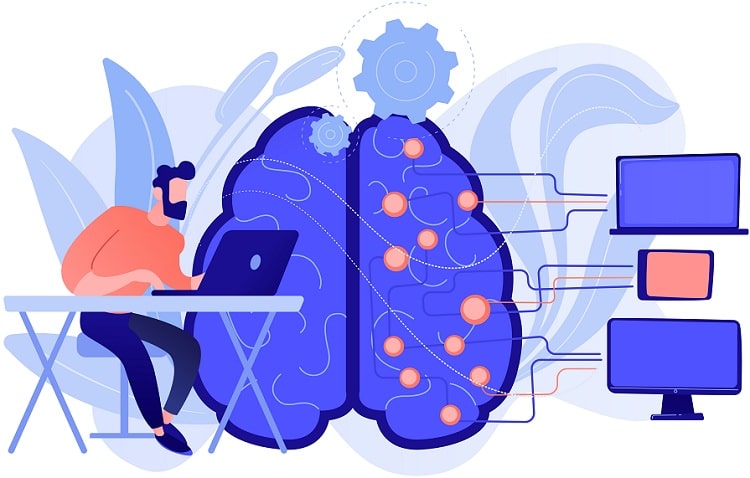Welcome to the ultimate guide on ”A Step-by-Step Guide to The Best Deep Learning Introduction.”
This comprehensive course will take you on a transformative journey into the fascinating world of deep learning.
Whether you’re an aspiring AI enthusiast or a seasoned professional seeking to improve your capabilities, this deep learning certification course will equip you with the essential knowledge and practical insights to master the foundations of neural networks, data preprocessing, and model optimization.
Join us as we unravel the complexities of deep learning step by step and unlock the potential to create cutting-edge AI solutions in real-world applications.
Let’s embark on this exciting adventure together!
Understanding Deep Learning:
Welcome to our comprehensive deep learning course, where You’ll start a thrilling voyage. into the realm of artificial intelligence.

This deep learning certification course is designed to provide a solid understanding of the principles and techniques underpinning this revolutionary field.
Through expert-led instruction and hands-on projects, you will explore the intricacies of neural networks, data preprocessing, and model optimization.
As you delve into the world of deep learning, you’ll gain the expertise to tackle complex challenges and unlock the potential of this cutting-edge technology. Join us now to unlock a world of possibilities in AI.
Foundations of Deep Learning:
Deep learning is the backbone of modern artificial intelligence and has revolutionized various industries.
At its core, wA subset of machine learning called “deep learning” focuses on employing neural networks with multiple layers to learn and extract patterns from vast datasets.
The key to its success is its ability to automatically learn hierarchical representations, enabling it to take on challenging assignments like image recognition, natural language processing, and game playing.
Deep learning’s origins can be dated back to the 1940s, but it was only with the advent of powerful computing hardware and abundant data that deep learning flourished.
Deep learning’s basic building block is the artificial neural network, inspired by the human brain’s neural connections. As information flows through these interconnected layers, each layer processes and refines the input data, making it increasingly abstract and relevant to the given task.
The training process involves adjusting the neural network’s weights using optimization algorithms to minimize errors, known as backpropagation. This combination of architecture and learning enables deep learning models to achieve remarkable accuracy and generalize to unseen data, paving the way for groundbreaking advancements in various domains.
Data Preprocessing for Deep Learning:
Data Preprocessing for Deep Learning is a crucial step that significantly impacts the performance of deep learning models.
It involves cleaning, transforming, and preparing the raw data before feeding it to the neural network. Here are the key pointers to consider in data preprocessing for deep learning:
- Data Cleaning: Removing duplicates, handling missing values, and dealing with outliers to ensure data quality and reliability.
- Feature Scaling: Normalizing or standardizing the features to bring them to a similar scale, preventing dominance by certain features.
- Data Transformation: Encoding categorical variables, one-hot encoding, or using embedding techniques for categorical data.
- Handling Imbalanced Data: Applying techniques like oversampling, undersampling, or generating synthetic samples to address class imbalances.
- Data Augmentation: Creating new training examples from existing data through rotation, flipping, or other transformations to increase dataset diversity.
- Feature Selection: Selecting relevant features reduces model complexity and improves training efficiency.
- Handling Text and Image Data: Special preprocessing techniques like tokenization for text or image resizing for image data.
- Data Splitting: Dividing the dataset into training, validation, and test sets to evaluate model performance effectively.
Proper data preprocessing ensures the deep learning model’s stability, efficiency, and generalization capabilities, leading to better outcomes in various applications.
Choosing the Right Framework:
Choosing the right deep learning framework between TensorFlow and PyTorch is a crucial decision that can significantly impact the success of your projects.
Both frameworks have their strengths and weaknesses, and your unique needs and preferences mostly determine the decision. Here are some key points to consider when making this decision:
- Ecosystem and Community Support: TensorFlow boasts a more extensive ecosystem with broader industry adoption, while PyTorch is known for its active research community and developer-friendly interface.
- Flexibility and Ease of Use: PyTorch’s dynamic computation graph makes experimentation more flexible and intuitive, whereas TensorFlow’s static graph offers better optimization opportunities.
- Performance and Scalability: TensorFlow excels in performance for production-scale models and deployment, while PyTorch shines for research and prototyping.
- Learning Curve: TensorFlow might have a steeper learning curve for beginners, whereas PyTorch’s more straightforward API makes it easier to start.
- Deployment Options: TensorFlow’s serving libraries and TensorRT integration make it a strong choice for deploying models in production environments.
- Industry Adoption: TensorFlow is widely used in industries such as Google, whereas PyTorch is popular among researchers and academic communities.
- Tutorials and Documentation: Both frameworks have comprehensive documentation and a wealth of tutorials, but TensorFlow’s vast user base often means more readily available resources.
- Updates and Development: Stay informed about the latest updates, advancements, and contributions from both TensorFlow and PyTorch communities.
Carefully consider your project’s specific requirements, team expertise, and plans to determine whether TensorFlow or PyTorch aligns better with your profound learning objectives.
Training Your First Deep Learning Model:
- Understand the fundamentals: Familiarize yourself with deep learning concepts and neural networks.
- Select a dataset: Choose a suitable dataset to train your model on.
- Preprocess the data: Clean, transform, and normalize the data for better performance.
- Choose an appropriate framework: Opt for popular frameworks like TensorFlow or PyTorch.
- Design the model architecture: Decide the number of layers, units, and activation functions.
- Define the loss function and optimizer: Specify how the model learns and updates its parameters.
- Train the model: Use the training data to optimize the model’s performance.
- Evaluate and fine-tune: Assess the model’s performance on a validation set and make necessary adjustments.
Optimizing Deep Learning Models:
- Efficient model design: Employing appropriate architecture, depth, and width to achieve better performance.
- Hyperparameter tuning: Fine-tuning learning rates, batch sizes, and regularization parameters to enhance model convergence.
- Advanced activation functions: Utilizing ReLU, Leaky ReLU, and Swish for better gradient propagation and reduced vanishing/exploding gradients.
- Batch normalization: Normalizing activations to stabilize training and improve generalization.
- Transfer learning: Leveraging pre-trained models to expedite training and boost accuracy on similar tasks.
- Hardware acceleration: Utilizing GPUs or TPUs to significantly accelerate computation and reduce training time.
- Pruning and quantization: Reducing model complexity by eliminating unnecessary parameters and using lower-precision data.
- Ensemble methods: Combining multiple models to improve performance and increase robustness.
Avoiding Common Pitfalls:
In deep learning, avoiding common pitfalls and efficiently troubleshooting projects can be the difference between success and frustration. One significant challenge is overfitting, where a model is effective on training data but cannot generalise on new data.
To counter this, practitioners should employ cross-validation, regularization, and data augmentation techniques. Another common pitfall is vanishing or exploding gradients, which can hinder convergence during training.
Adjusting learning rates and using gradient clipping are effective remedies to tackle this issue.
Moreover, improper data preprocessing can introduce errors in the model. Ensuring data consistency, handling missing values, and normalizing inputs are crucial steps to avoid such problems.
Hyperparameter tuning should be addressed but plays a vital role in model performance. Systematic experimentation with hyperparameters can significantly enhance a model’s capabilities. Additionally, the lack of computational resources can hinder progress.
Utilizing cloud-based solutions or leveraging pre-trained models can alleviate this limitation. Deep learning projects can achieve their full potential with greater accuracy and robustness by being aware of these pitfalls and implementing appropriate strategies.
Real-World Applications of Deep Learning:
Real-world applications of deep learning have revolutionized numerous industries, showcasing its transformative potential.
In healthcare, it aids in medical imaging analysis, diagnosing diseases with exceptional accuracy.
In finance, deep learning enables fraud detection and stock market prediction. Moreover, it powers autonomous vehicles, enhancing safety on roads.
Natural language processing drives advancements in virtual assistants and translation services.
Industries like manufacturing and agriculture benefit from predictive maintenance and crop monitoring.
With its ability to extract patterns and insights from vast data, deep learning continues to unlock innovative solutions, shaping a smarter and more efficient world.
Summary
This comprehensive step-by-step guide is the ideal foundation for anyone venturing into deep learning. Learners can confidently embark on their deep learning journey by clearly understanding neural networks, data preprocessing, and model training.
Whether aiming to build a career in artificial intelligence or seeking personal growth, this guide lays the groundwork for success.
Embracing this deep learning course will undoubtedly empower individuals to unlock their potential and pave the way for future achievements in artificial intelligence and beyond, making it a valuable deep learning certification course.
More Great Contents:



















